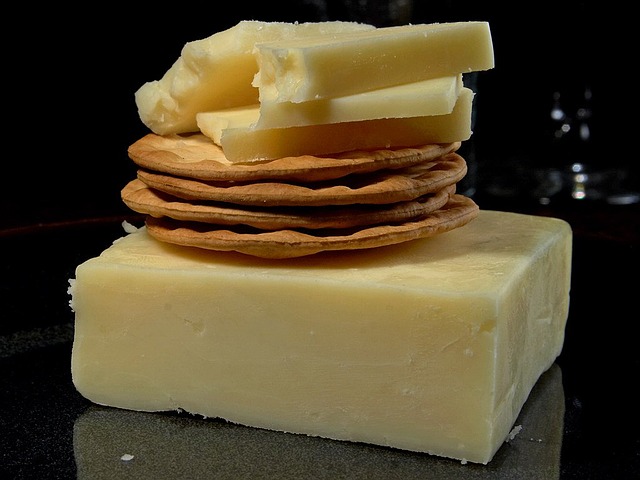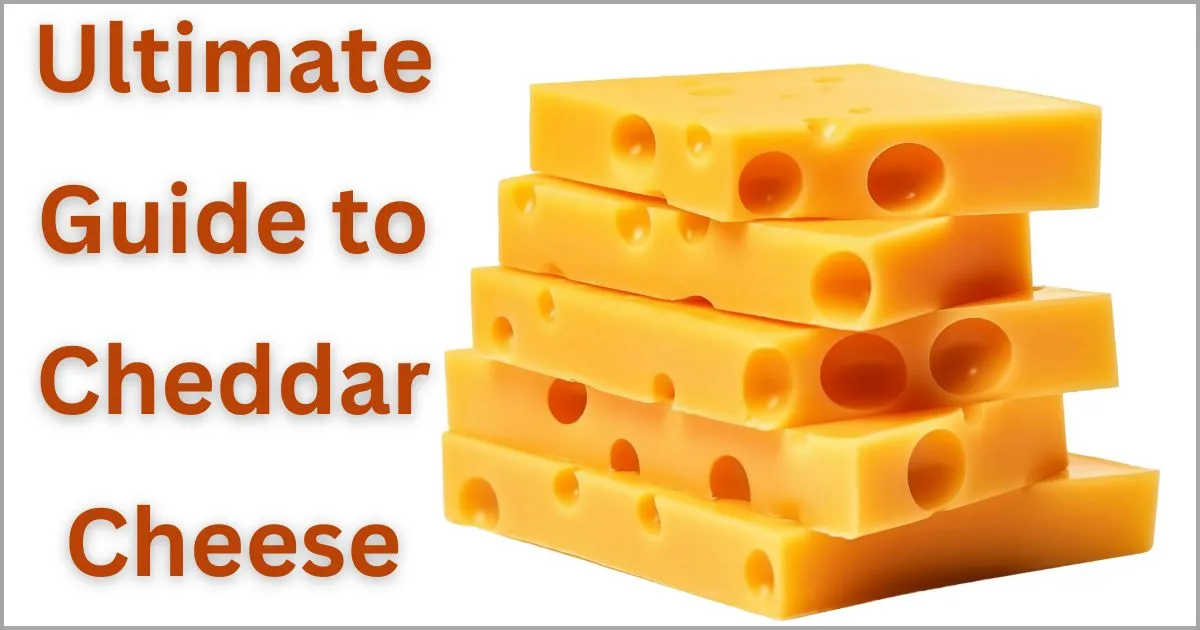Cheddar cheese is a beloved staple in kitchens around the world, renowned for its rich flavor and versatility. Whether you’re a cheese connoisseur or a casual consumer, this guide will provide you with everything you need to know about cheddar cheese, from its origins to its various types and culinary uses.
Cheddar Cheese: Key Details
- Source of Milk: Cow milk
- Texture: Firm and smooth, can range from crumbly to creamy
- Colour: Typically yellow to orange, though it can also be white
- Flavour: Sharp, tangy, and nutty; flavor intensity varies with aging
- Fat Content: 33-35%
- Aging Time: Aged from 1 month to several years
- Pasteurized: Can be either pasteurized or raw, depending on the type
- Country of Origin: England
- Town: Originated in Cheddar, Somerset
- Named After: The town of Cheddar in Somerset, England
- Certification: Some varieties, such as West Country Farmhouse Cheddar, have Protected Designation of Origin (PDO) status
- Uses: Ideal for sandwiches, burgers, mac and cheese, and as a cooking ingredient
The History of Cheddar Cheese
Cheddar cheese originated in the English village of Cheddar in Somerset, dating back to the 12th century. This classic cheese was traditionally made in cylindrical molds, wrapped in cloth, and aged in the Cheddar Gorge caves. The unique environment of these caves contributed to the cheese’s distinct flavor and texture.
Over time, cheddar cheese spread beyond England, gaining popularity worldwide. Today, it is produced in numerous countries, each adding its unique twist to the traditional recipe.

Types of Cheddar Cheese
Cheddar cheese comes in various forms, each with its unique characteristics. Here are some of the most common types:
1. Mild Cheddar
Mild cheddar is aged for the shortest period, typically between two to three months. It has a smooth, creamy texture and a subtle, milky flavor, making it a favorite for sandwiches and melting purposes.
2. Medium Cheddar
Aged for around six months, medium cheddar offers a balance between mild and sharp varieties. It has a firmer texture and a slightly more pronounced flavor, ideal for those who want a bit more intensity without overwhelming sharpness.
3. Sharp Cheddar
Sharp cheddar is aged for nine months to a year. Its crumbly texture and robust, tangy flavor make it a standout ingredient in recipes where a strong cheese presence is desired, such as in macaroni and cheese or cheese boards.
4. Extra Sharp Cheddar
Extra sharp cheddar is aged for over a year, sometimes up to several years. This aging process results in a very crumbly texture and a potent, complex flavor. It’s perfect for those who love a bold, intense cheese experience.
5. White Cheddar
White cheddar is essentially the same as other cheddars but without the addition of annatto, a natural coloring agent. It can be found in all aging stages, from mild to extra sharp, and has a slightly different taste profile, often described as creamier.
Nutritional Benefits of Cheddar Cheese
Cheddar cheese is not only delicious but also nutritious. It is a good source of essential nutrients, including:
- Protein: Cheddar cheese is high in protein, which is essential for muscle growth and repair.
- Calcium: It provides a significant amount of calcium, crucial for strong bones and teeth.
- Vitamin A: This vitamin is vital for maintaining good vision and a healthy immune system.
- Vitamin B12: Important for red blood cell formation and neurological function.
However, it’s important to consume cheddar cheese in moderation due to its high saturated fat and sodium content.
Culinary Uses for Cheddar Cheese

Cheddar cheese’s versatility makes it a favorite in many dishes. Here are some popular ways to use it:
Grilled Cheese Sandwich
A classic comfort food, the grilled cheese sandwich is simple yet satisfying. Use mild or medium cheddar for a creamy melt or sharp cheddar for a more intense flavor.
Macaroni and Cheese
Macaroni and cheese is a beloved dish that showcases cheddar’s melting properties. Sharp or extra sharp cheddar adds a deliciously tangy kick.
Cheese Board
A cheese board isn’t complete without cheddar. Pair extra sharp cheddar with fruits, nuts, and crackers for a delightful appetizer.
Burgers
Cheddar cheese melts beautifully on burgers, adding a rich, creamy layer of flavor. Medium or sharp cheddar works best for this purpose.
Soups and Stews
Grated cheddar can enhance the flavor of soups and stews. Add it to broccoli cheese soup or sprinkle on top of chili for an extra layer of taste.
Storing and Serving Cheddar Cheese

To maintain cheddar cheese’s quality, store it properly. Wrap it in wax paper or parchment paper, then place it in an airtight container in the refrigerator. This method allows the cheese to breathe while preventing it from drying out.
When serving cheddar cheese, allow it to come to room temperature for the best flavor and texture. This typically takes about 30 minutes to an hour.
Conclusion
Cheddar cheese is a versatile and flavorful addition to any kitchen. Whether you prefer it mild or extra sharp, white or colored, there’s a cheddar variety to suit every palate. By understanding its history, types, and uses, you can fully appreciate this beloved cheese and incorporate it into your culinary creations. Enjoy exploring the world of cheddar cheese and savouring its delicious possibilities!

